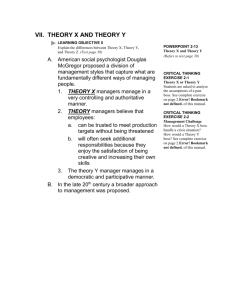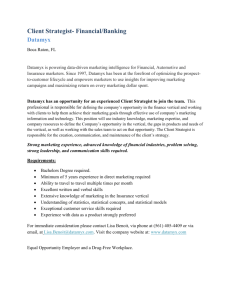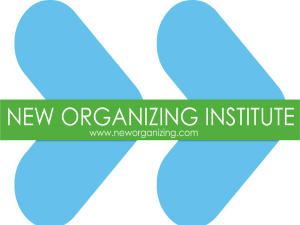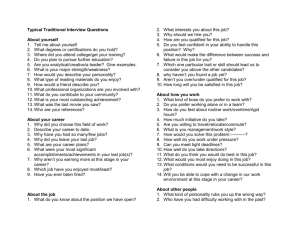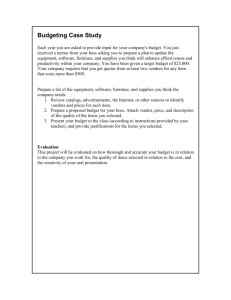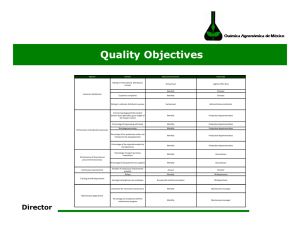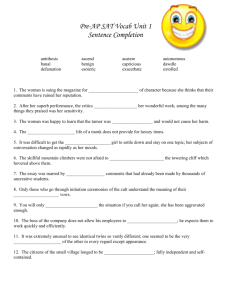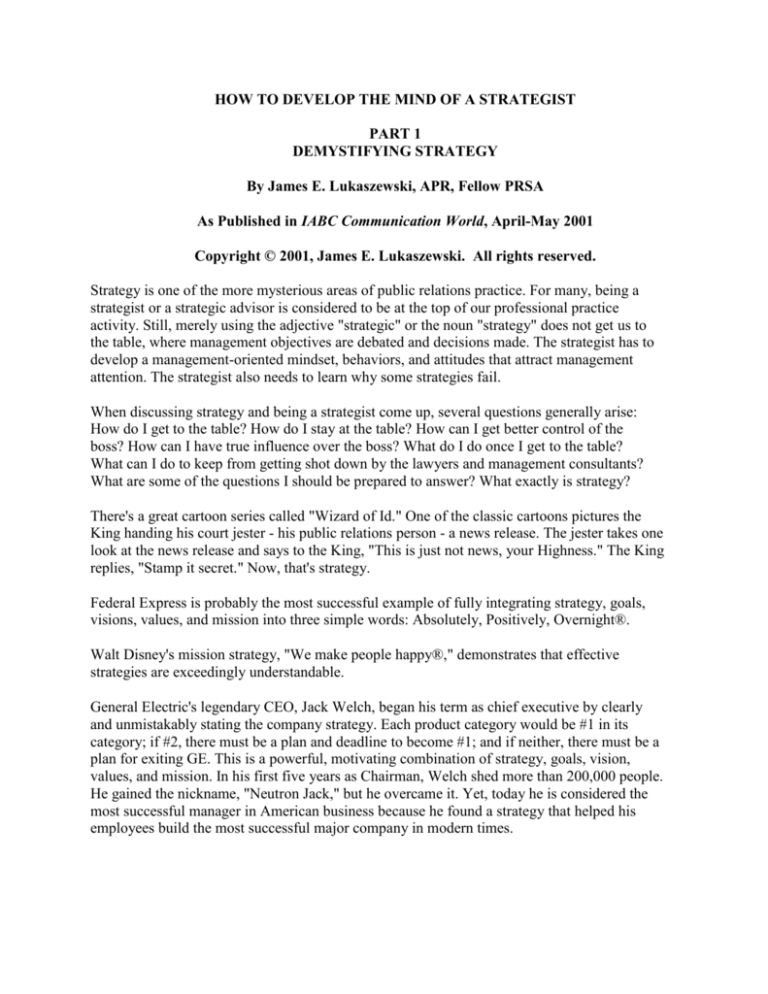
HOW TO DEVELOP THE MIND OF A STRATEGIST
PART 1
DEMYSTIFYING STRATEGY
By James E. Lukaszewski, APR, Fellow PRSA
As Published in IABC Communication World, April-May 2001
Copyright © 2001, James E. Lukaszewski. All rights reserved.
Strategy is one of the more mysterious areas of public relations practice. For many, being a
strategist or a strategic advisor is considered to be at the top of our professional practice
activity. Still, merely using the adjective "strategic" or the noun "strategy" does not get us to
the table, where management objectives are debated and decisions made. The strategist has to
develop a management-oriented mindset, behaviors, and attitudes that attract management
attention. The strategist also needs to learn why some strategies fail.
When discussing strategy and being a strategist come up, several questions generally arise:
How do I get to the table? How do I stay at the table? How can I get better control of the
boss? How can I have true influence over the boss? What do I do once I get to the table?
What can I do to keep from getting shot down by the lawyers and management consultants?
What are some of the questions I should be prepared to answer? What exactly is strategy?
There's a great cartoon series called "Wizard of Id." One of the classic cartoons pictures the
King handing his court jester - his public relations person - a news release. The jester takes one
look at the news release and says to the King, "This is just not news, your Highness." The King
replies, "Stamp it secret." Now, that's strategy.
Federal Express is probably the most successful example of fully integrating strategy, goals,
visions, values, and mission into three simple words: Absolutely, Positively, Overnight®.
Walt Disney's mission strategy, "We make people happy®," demonstrates that effective
strategies are exceedingly understandable.
General Electric's legendary CEO, Jack Welch, began his term as chief executive by clearly
and unmistakably stating the company strategy. Each product category would be #1 in its
category; if #2, there must be a plan and deadline to become #1; and if neither, there must be a
plan for exiting GE. This is a powerful, motivating combination of strategy, goals, vision,
values, and mission. In his first five years as Chairman, Welch shed more than 200,000 people.
He gained the nickname, "Neutron Jack," but he overcame it. Yet, today he is considered the
most successful manager in American business because he found a strategy that helped his
employees build the most successful major company in modern times.
The most effective goals and the strategies to achieve them are simple, positive, focused, time
sensitive, understandable, and achievable. How do your mission, vision, values, and business
strategy measure up?
Lukaszewski's Definition of Strategy
Strategy is a unique mixture of mental energy verbally injected into an organization
through communication, which results in behavior that achieves organizational
objectives.
Strategy is a key attribute of leadership.
Strategy is the energy that drives businesses and organizations, guides leadership, and
directs the team.
Strategy draws people in the same direction.
Strategy is a positive, energizing state of mind.
Strategy is also:
Momentum for the current plan of action.
Moral and ethical guidelines for achieving goals.
Crucial intellectual ingredients for success and victory.
What is not strategic?
Focusing on the unimportant is not strategic.
Teaching the value of staff functions is not strategic.
Labeling actions and ideas as strategic is not necessarily strategic.
Suggesting "stuff" is not strategic.
Lots of people think they have something strategic to offer and deserve to be at management's
table without really knowing what strategy is.
Often, I have the opportunity to speak to and interact with other staff professionals - lawyers,
accountants, human resource specialists, security experts, financial professionals, and
information systems gurus. The questions they all ask are those from the list I shared earlier:
"How do we get to the table?" "How do we get management to hear us and act on what we
say?" These questions have a very familiar ring.
I also spend a fair amount of time talking with and counseling CEOs and operating executives.
You may find their perspective on our getting to the table quite interesting. Their rhetorical
question is, "How do I manage all these people who constantly yak at me, who know virtually
nothing about the business or what I care about, but want to tell me how to run the business?"
"They all clamor for a seat at the table. The place is already overcrowded with folks who don't
know how to help me. Spare me these amateurs." "Who are these people anyway?" they ask.
Strategy begins with how you think about:
The issues, problems, or questions management needs to address.
How management analyzes and approaches its problems.
A translation process to help management to understand the insights you intend to share.
A strategist:
Has exceptional verbal skills.
Communicates effectively in real time, on the spot, because that's how managers make
decisions.
Focuses on what is truly and indisputably important.
Helps everyone recognize the obvious.
In an early draft of the Hound of the Baskervilles, Sir Arthur Conan Doyle has Sherlock
Homes and Dr. Watson camping out on a moor. In the middle of the night, Holmes suddenly
awakes and shakes Watson, exclaiming, "Look at the sky, Watson. What do you see?" Watson
replies, "I see stars, millions and millions of stars." Holmes persists, "And what does that tell
you, Watson?" Dr. Watson pauses. "Astronomically, it tells me that there are millions of
galaxies and countless planets in them. Horologically, it tells me that the time is quarter past
three. Astrologically, it tells me that Saturn is in Leo. Theologically, it tells me that God is allpowerful and that we are small and insignificant. Meteorologically, it tells me that we will have
a nice day tomorrow." Holmes says nothing. Watson finally asks, "Well, Holmes, what does all
this beauty and grandeur tell you?" The detective snaps, "Watson, you idiot, it tells me that
someone has stolen our tent."
The obvious can often be a powerful strategic insight.
Management wants and needs:
Valuable, useful, applicable advice beyond what the boss already knows.
Well-timed, truly significant insights. Insight is the ability to distill wisdom and useful
conclusions from contrasting even seemingly unrelated information and facts.
Advance warning, plus options for solving, or at least managing trouble or opportunity, and
the unintended consequences both often bring.
Someone who understands the pattern of events and problems.
Supporting evidence through the behavior of their peers.
To be strategic ideas must pass four tough tests:
Help the boss achieve his or her objectives and goals.
Help the organization achieve its goals.
Be truly necessary (and pass the straight face and laugh tests).
Without acting on the strategy recommended, some aspects of the business will fail or fail
to progress.
Public relations practitioners tend to fail as strategists because:
PR solutions aren't necessarily a critical part of every management decision or problem
scenario.
Worrying out loud about how the media are treated or how hard reporters work has only a
limited value to management.
Media concerns are rarely management's first concerns.
Spilling your guts is not a strategy.
PR is not viewed as a bottom-line function (no matter how hard we try to sell the idea).
We may notice management's blind spots or prejudices, but we are often powerless - or
idealess - to make a useful, doable, meaningful recommendation to fill the voids or correct
management misperceptions.
We whine a lot about other staff functions, the lawyers and consultants.
Whining is not a strategy.
Strategies can fail because:
They aren't really part of management's strategic interest or focus.
Management will not or cannot support or participate.
They are developed without input from the boss or someone the boss trusts.
They usurp the legitimate territory of others.
They avoid dealing with the truly tough stuff, such as:
Getting the stock price to move.
Taking market share.
Gaining attention for non-newsworthy stuff.
Building business.
Solving the key problems the business or its bosses face.
Influencing employee, public, customer, or shareholder behaviors.
Having strategic impact requires five ingredients:
Management language.
Truly strategic insight.
Talking, thinking, and recommending in an operational context.
Focus on the ultimate outcome.
Important knowledge of the business.
How can you tell if you or someone you work with is strategic? If you are a strategist,
you:
Are inconsistent.
Recommend conclusive action increments.
Provide substantive intensity.
Believe in laggership and entropy as strongly as action and solutions.
Are a pragmatist.
Focus on the top executive's goals, perceptions, and vision.
Realize that not all news is good news.
To get to and stay at the table, aspiring strategists need to dump their cynicism about
management and get on the team.
James E. Lukaszewski. APR, Fellow PRSA, is one of the most prolific public relations writer,
teachers, and thinkers in America today. This article and its two remaining sections reflect one
of the areas Mr. Lukaszewski is most known for, being a communications strategist. Part II,
"Having Strategic Impact," will discuss why strategies fail, using management language, how
to have strategic insight, and making recommendations in an operational context. Part III, "See
You at the Table," describes how the communicator can provide information strategically
useful to management and the business, why strategy is a big picture activity, how to be a force
for prompt positive forward thinking, incremental constructive action. You can contact Mr.
Lukaszewski by E-mail at tlg@e911.com and visit his extensive, content-rich Web site at
http://www.e911.com/.
HOW TO DEVELOP THE MIND OF A STRATEGIST
PART 2
HAVING STRATEGIC IMPACT
By James E. Lukaszewski, APR, Fellow PRSA
As Published in IABC Communication World, June-July 2001
Copyright © 2001, James E. Lukaszewski. All rights reserved.
In this section of this three-part series, the author talks about how to use management language
effectively and shares the key ingredients of developing the mind of a strategist.
Management Language
Two years ago, I attended a conference of the PRSA's Counselor's Academy, which focused
almost entirely on how management consultants are invading the public relations counseling
arena. These consultants are receiving a very positive reception.
Diane Fusco of Cleveland told the story of how her agency was acquired by a regional
management consulting firm and described the effect it had on her as a practitioner as well as
on how her business thinking and strategy were restructured.
The first thing that changed was the vocabulary. The list of the service descriptions for her new
management communications and strategic communication counsel function speaks for itself:
Customer/loyalty management.
Strategic planning.
Customer centered re-engineering.
Executive and management development.
Staff development.
Team building.
Organizational operational review and analysis.
Corporate marketing and communications.
Crisis consulting.
Issues/Exposure management.
Notice that the word communication appears on the list only once. This is a very operationally
oriented presentation of concepts. Those who run large businesses and organizations are almost
totally operationally focused.
Diane learned that to successfully deal with management, she either had to speak management
language or translate what she was trying to get across into terms management could
understand, care about, and act on.
Perhaps this is our greatest challenge because our thinking methodology, expectations, and
vocabulary are so different from management's. One of the fundamental realities of successful
management is the ability to get things done over the long term: moving people, materials,
resources, and concepts into and through profitable or useful deployments. This requires a
process strategy, a motivation strategy, and a mission.
This process is the complete opposite of most public relations work. We get it done now. If you
don't need it now, call us just before you do. Management generally prefers a more measured
process
In the absence of strategy, public relations work (from the management perspective) has
essentially one reason for its existence and only one reason: to get appropriate publicity to
build reputation, acceptability, or admiration of the company, its executives, and products.
Management thinking is long-term process thinking. Public relations thinking is shorter-term,
often instantaneous intuitive thinking. It is the public relations practitioner's job to make the
two thinking styles come together. The operating executive doesn't have to care.
Strategic Insight
Strategic thinking helps us understand how managers approach problems. Knowing how
managers think is crucial to becoming an effective strategist. Before insights can be shared, a
mutually acceptable language needs to be used.
The world is fundamentally run by process thinkers, managers, and highly trained individuals
such as lawyers, physicians, engineers, and scientists. When they approach a problem, they
divide it, from their perspective, into symmetrical, logical, sequential segments (either
alphabetical, chronological, or in some other systematic way) and proceed to work and think in
an orderly, logical, incremental fashion. The product of process thinking is a fairly evenhanded
predictable approach and structure. It can be a useful, thorough problem-solving approach.
Creative people, on the other hand - public relations people, writers, journalists, artists, painters
- are predominantly intuitive people. We tend to work subtractively, that is, when we are
presented with a problem, idea, or challenge, we tend to look for the single most brilliant,
unusual, or surprising approach and attempt to prove the importance of this approach to
managers if and when we're asked. Remember that the manager is taught in management
school or through practice to approach things in an orderly, logical, incremental fashion. The
person who comes along with the magic answer to the problem without any substantive
support, evidence, or process approaches is suspect, not credible or "not serious." The product
of intuitive thinking is the "big idea" or the "silver bullet," a goal that is rarely achieved or is
achievable.
There is a third way, the strategic way. In the strategic thinking model, problems or situations
are analyzed and divided into their constituent parts on purpose. The objective is coming up
with a supportable, meaningful, but completely unusual approach, one that is based first on
totally new sets of assumptions or at least innovative challenges to old assumptions.
The product of strategic thinking is a range of options and approaches, plus the assumptions
and the rationale that support them. Management expects a menu of decision options to
consider. That's because management knows there are many ways to achieve any task or goal.
Early in World War II, when Britain was fighting the war virtually alone in Europe, it was
suffering enormous losses of its aircraft. Doing nothing was not an option. The best brains in
Britain and America were put to work on the problem. The planes, which returned, were all
shot up, and so one option to increase survivability was to reinforce those areas of the aircraft
that were damaged. But the losses only continued to mount. Then, one night, someone had a
brainstorm. He suddenly realized that because they couldn't examine the planes that didn't
come back, perhaps the answer was to reinforce those places on returning aircraft that weren't
shot up rather than those places that were! The result was that aircraft losses dropped
dramatically and consistently throughout the remainder of the war.
Challenge assumptions; always look for novel approaches.
The product of strategic thinking is a range of options and approaches, plus the new
assumptions and the rationale that support them.
Making Recommendations in an Operational Context
Public relations executives have to rebuild their credibility with management every day.
Credibility requires that the consultant somehow learns to think and explain his or her concept
within a framework management recognizes. Management won't be taught public relations;
they don't want to learn. They won't be taught any other staff functions either. That's why they
hire staff people. Management's job is to run the business. Staff's job is to help management do
just that. Besides, most executives I've worked with throughout my career were far better
public relations people in their business area than I could ever be. That's because they actually
knew what their business was about and understood its shortcomings, opportunities, potential,
and real condition.
In my experience, 85 percent of public relations, in a business context, can be done by a
competent secretary. This is not an insult; it's the truth. The boss knows it; people who work
for the boss and run the business know it; you know it. Yet, it's a lesson we need to remember.
Somehow, we believe that if we produce enough stuff, even good stuff, the boss will somehow
like us, invite us to the table, and, overlooking our lack of strategic view, include us in major
planning efforts. Stuff is not a ticket to the table to participate.
If you focus on stuff, you'll never get to the table. So how do you convey your ideas to
management in ways that seem valuable, useful, or strategic? The answer is in a very
organized, process-driven manner. Here's an approach I like, which has only five steps. I call it
the Executive Decision-Making Process. It is designed to be factual, forceful, complete, and
brief.
The Two-Minute Drill
Managers seem to accept the Executive Decision-Making Process well as it's a simple, direct
process for giving those you help focused, accurate, and complete information from which to
choose a course of action. Think of it as a two-minute strategy drill where you are both
quarterback and coach. You are only going to get two minutes, and you want to stay in the
game.
The five elements of the process are situation description, analysis and explanation, options,
recommendations, and negative unintended consequences. Here are the steps in the process:
Executive Decisions-Making Process
Step 1. Situation description: Briefly describe the nature of the issue, problem, or situation.
Step 2. Analysis/explanation/interpretation: Briefly describe what the situation means, its
implications, and how it threatens or presents opportunities for your organization.
Step 3. Options: Develop at least three response options for the situation you presented. You
can suggest more, but three is optimal for management to choose from. Make sure that one of
the options is "doing nothing."
Step 4. Recommendations: This is what you would do if you were in your boss' shoes, and
why.
Step 5. Negative unintended consequences: Identify the events and problems that could arise
due to the options you have suggested or by doing nothing. Also, forecast collateral damage to
be expected.
The Executive Decision-Making Process is shown in Figure 1 below.
TIPS FOR
SUCCESSFUL USE
EXECUTIVE DECISION MODEL
If you write it down:
1. Situation Description (facts/data):
_______________________________________________
_______________________________________________
2. Analysis/Explanation/Interpretation (impact):
_______________________________________________
_______________________________________________
3. Options (pathways to a solution):
_______________________________________________
_______________________________________________
4. Recommendation(s) (If I were you, here's what I'd do.):
_______________________________________________
_______________________________________________
5. Negative unintended consequences:
_______________________________________________
_______________________________________________
1. Keep it to one page,
one side.
2. Use positive, direct,
power language.
3. Provide at least three
options, one being doing
nothing.
4. Put yourself in the
boss' shoes when you
decide which of the
options you're going to
select as your
recommendation.
5. Forecast collateral
damage.
Figure 1
This approach has value to management. If you simply make suggestions with no format or
self-evident structure, what you suggest will be analyzed only from only two perspectives:
does your recommendation make money, or does it save money? Public relations can virtually
never definitively demonstrate either of these, unless the boss approves of the methodology.
Public relations as a bottom-line function is mostly a red herring argument anyway. Public
relations, to be of strategic value to management, must make a powerful, self-evident
management contributions to the management decision-making process.
James E. Lukaszewski. APR, Fellow PRSA, is a public relations writer, teacher, and thinker.
You can contact Mr. Lukaszewski by E-mail at tlg@e911.com and visit his Web site at
http://www.e911.com/. Watch for Part III, "See You at the Table," which describes how the
communicator can provide information strategically useful to management and the business,
why strategy is a big picture activity, and how to be a force for prompt positive forward
thinking, incremental constructive action within your organization.
HOW TO DEVELOP THE MIND OF A STRATEGIST
PART 3
SEE YOU AT THE TABLE
By James E. Lukaszewski, APR, Fellow PRSA
As Published in IABC Communication World, August-September 2001
Copyright © 2001, James E. Lukaszewski. All rights reserved.
Important Business Knowledge
One of the communications strategist's main values is to provide the boss with effective
information with which to know and run the business. Bosses generally look for six kinds of
feedback:
Data feedback: Facts and information.
Feeling feedback: Emotional intelligence about the states of minds of various
constituencies.
Intelligence of the old-fashioned kind: What is going out there, what should he/she know
about that no one else knows about, where is the edge?
Advance information: Threats and exposure, unplanned visibility, organizational impact
forecast.
Real-time concerns: What are the things that executives should worry about today, tonight,
and tomorrow morning; what can be deferred and why.
Peer activities: Strategies, mistakes, and successes.
To act truly in the interests of the business by bringing in useful knowledge beyond that
already known, the strategist faces tough personal questions:
Can you separate yourself from your own predispositions, assumptions, and largely antimanagement biases?
Can you add positive energy to what management has to accomplish?
Can you move different constituencies to listen and to act?
Can you build the expectation of a strategic contribution from you, in management's eyes?
Can you expect a call from the boss to help think things through?
Can you assess, then clearly and quickly analyze the impact of bad news? Good news? No
news?
Can you fill management's blind spots and suggest ways to overcome management's
limitations?
Can you manage your ego throughout the process?
Can you work successfully at a fairly substantial altitude and keep the bigger picture in
mind?
Focus on the Ultimate Outcome
Strategy is a big-picture activity. It is always outcome focused. That's because strategy is
virtually always about the future. Strategy is a kind of magnetism that pushes, pulls, and
adjusts the business in the larger context of its operations, but always in a forward direction.
Too often public relations and other staff functions get bogged down in what happened
yesterday, last week, last month, or last budget cycle. We spend far too much time trying to
figure out how we got to where we are.
Five years ago, I was working to resolve the differences and build a working relationship
between five very disparate organizations - labor unions, religious organizations, nongovernment organizations (NGOs), activists, and a very large business. The result of their
inability to get together was public bickering, arguing, demonstrations, and very dangerous,
potentially explosive confrontations.
At the suggestion of some very helpful people, one November day in 1995 we all wound up in
the living room of a Presbyterian minister in East Brooklyn. That's just across the river from
Manhattan. When we arrived, a very jovial, large man invited us into his comfortable living
room where a roaring fire greeted us. When the six of us sat down - one labor leader, one
religious leader, one NGO leader, two individuals from the company, and me - Reverend Smith
laid down the only ground rule for the day. He said, "Today's discussion will be outcome
focused. By that I mean that anything that happened this morning, yesterday afternoon, last
week, last month, last year, the last decade, the last century is irrelevant to today's discussion.
We will stay focused on what we can get done based on where we know we have to go. Should
any of you feel you must move backwards, I will nudge you forward. If you cannot go forward,
then I will invite you to leave so that my wife and I can have a pleasant Sunday afternoon."
This was an incredibly important meeting. After five years of painful, dangerous disagreement,
in four and one-half hours we developed a one-page agreement, which was signed by
everyone. All of these organizations are operating under this agreement to this day. I attribute
amazing success to the notion of "outcome focus."
The strategist is informed by the past but chooses those lessons that help show direction to the
future. This is what is known as "outcome focus."
Outcome-focused meetings are at least 50 percent shorter. Time is not wasted discussing what
can't be changed. Forget the past. Recognize that everyone, from their own perspective, already
owns some part of the past in ways we can never understand. Focus on the future, which no
one owns and no one can forecast accurately. In strategy, we all come to the future completely
equal with every other staff function or management advisor. Victory can only be designed
when there is total focus on the future. It is very hard to go forward while looking and thinking
backward. Achieving success and obtaining goals happens in the future, never in the past.
Strategy Is Always About the Future
You can be a successful strategist anywhere in your organization. Success does not require that
you even be at the table. You do have to be sought out by the boss or someone the boss trusts.
If you offer value, and the boss knows of that value and has respect for your thinking, you will
be sought out. The person who is sought out is the person who can contribute something
positive, useful, and of self-evident value, from the boss' perspective.
So what are the main lessons I'm trying to share about becoming and developing the mind of a
strategist? I think there are three.
First, always think in terms of action options, including doing nothing. Doing nothing is the
most challenging strategy to figure out unless the boss or lawyers mention it first. Then you
will do nothing - for a while. If you want to be a strategist, you have to be first to mention
doing nothing, then explaining, if you can, why other options are better, more acceptable, or
will lead to victory. In its simplest form, doing nothing is often the most appealing strategy for
most managers, at least in the beginning.
Second, be a force for prompt, positive, forward thinking, outcome focused incremental,
constructive action. Avoid the negativity, defensiveness, and time wasting whining executives,
particularly those in difficult situations, tend to enjoy. Be reflective, but take only useful,
positive lessons from the past.
Third, approach business problems from a business perspective. Use a management context.
Separate yourself from the strictly media and the media relations solution. If all you can think
of is what the press release ought to say, you're of very little value in strategic situations.
When it comes to being a strategist - a successful, counter intuitive, energetically positive
thinker - your focus must remain on the success of the team, its leadership, and promptly
achieving useful, important, positive goals.
Strategy is a tough challenge for tough-minded thinkers and relentlessly action-oriented doers.
It's like the apocryphal story of the young journalist interviewing Thomas Edison just after
Edison successfully invented the light bulb. The enthusiastic young journalist said, "Mr.
Edison, I understand it took you 6,000 attempts to perfect the light bulb." Mr. Edison replied, "
That's probably correct." The reporter continued questioning, "Help me understand how a man
of your obvious learning, knowledge, skill, ability, and creativity could make 6,000 mistaken
attempts to make a simple light bulb. Isn't that embarrassing? Or aren't you as smart as your
public relations people say you are?" Thomas Edison then reportedly replied, "Well, young
man, I just ran out of ways to do it wrong."
If you can genuinely put yourself in the boss' shoes and look at things from an operational
perspective, talk in the vocabulary of management, think and recommend using strategic
management process approaches, then apply what you know how to do to that which
management really needs done and what is truly important, you will have developed the mind
of a strategist. You'll be sought out. Count on it.
See you at the table.
James E. Lukaszewski. APR, Fellow PRSA, is a U.S.-based public relations writer, teacher,
and thinker. This article is the last in a three-part series, "How to Develop the Mind of a
Strategist." You can contact Mr. Lukaszewski by E-mail at tlg@e911.com and visit his Web
site at http://www.e911.com/
Copyright © 2001, James E. Lukaszewski. Permission granted to reprint with
attribution.

